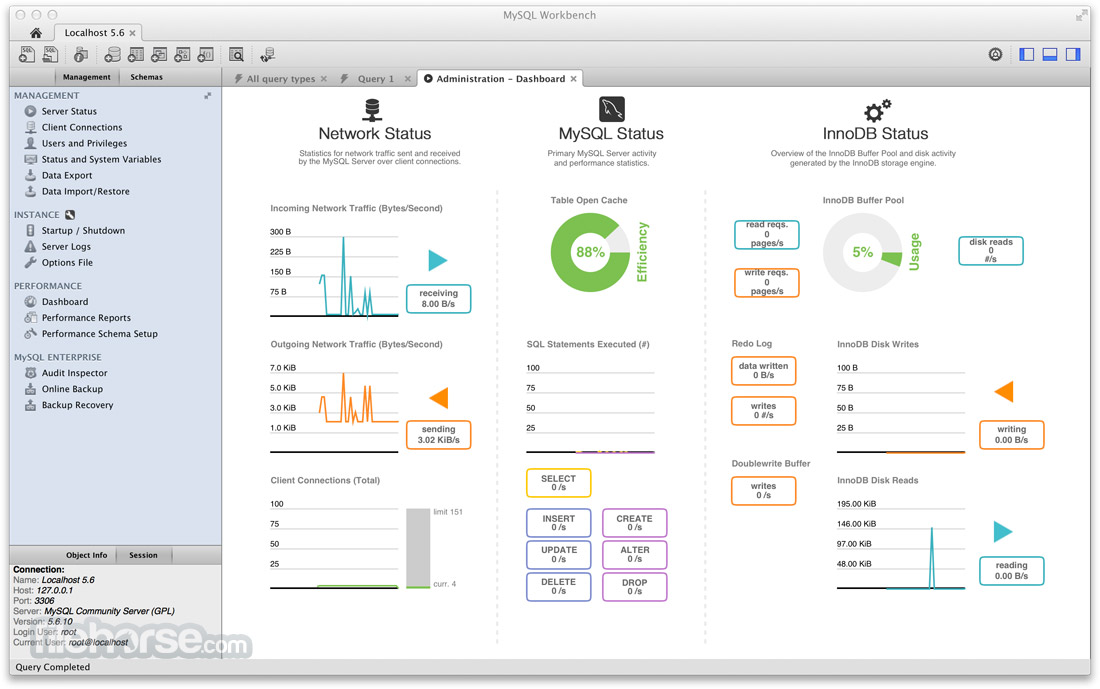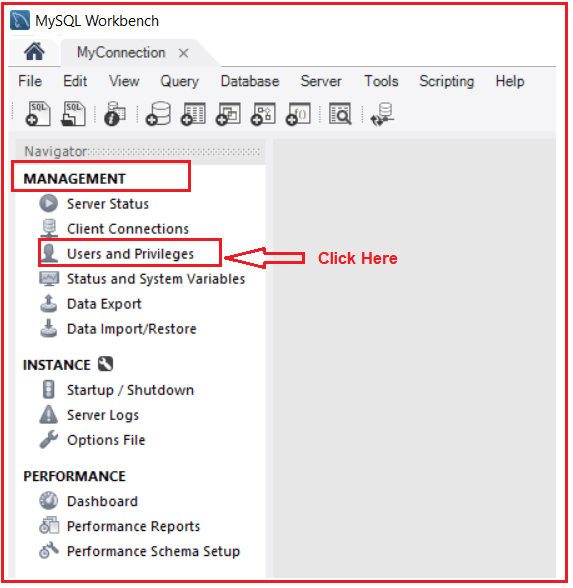

- Create user mysql workbench how to#
- Create user mysql workbench full#
- Create user mysql workbench code#
SELECT current_role() Code language: SQL (Structured Query Language) ( sql ) If you invoke the CURRENT_ROLE() function, it will return NONE, meaning no active roles. This is because when you granted roles to a user account, it did not automatically make the roles to become active when the user account connects to the database server. The statement issued the following error message: ERROR 1044 (42000): Access denied for user to database 'crm' Now if you connect to the MySQL using the crm_read1 user account and try to access the CRM database: >mysql -u crm_read1 -p The statement returns the following output: Setting default roles To show the privileges that roles represent, you use the USING clause with the name of the granted roles as follows: SHOW GRANTS FOR crm_write The statement returned the following result set:Īs you can see, it just returned granted roles. To verify the role assignments, you use the SHOW GRANTS statement as the following example: SHOW GRANTS FOR language: SQL (Structured Query Language) ( sql ) TO language: SQL (Structured Query Language) ( sql ) The following statement grants the crm_read and crm_write roles to the user accounts and GRANT crm_read, The following statement grants the crm_read role to the user account GRANT crm_read TO Code language: SQL (Structured Query Language) ( sql ) The following statement grants the crm_rev role to the user account GRANT crm_dev To assign roles to users, you use GRANT statement.

read/write users CREATE USER IDENTIFIED BY 'Secure$9075' ĬREATE USER IDENTIFIED BY 'Secure$3452' read access user CREATE USER IDENTIFIED BY 'Secure$5432' To create new users, you use CREATE USER statements as follows: - developer user CREATE USER IDENTIFIED BY 'Secure$1782' Suppose you need one user account as the developer, one user account that can have read-only access and two user accounts that can have read/write access. TO crm_write Code language: SQL (Structured Query Language) ( sql ) Assigning roles to user accounts The following statement grants INSERT, UPDATE, and DELETE privileges to crm_write role: GRANT INSERT, UPDATE, DELETE ON crm.* TO crm_read Code language: SQL (Structured Query Language) ( sql ) The following statement grants SELECT privilege to crm_read role: GRANT SELECT ON crm.*

The following statement grants all privileges to crm_dev role: GRANT ALL ON crm.* To grant privileges to a role, you use GRANT statement. If you omit the host part, it defaults to ‘%’ that means any host. The role name is similar to the user account that consists of two parts: the name and host: Code language: SQL (Structured Query Language) ( sql ) To create new roles, you use CREATE ROLE statement: CREATE ROLEĬrm_write Code language: SQL (Structured Query Language) ( sql ) To avoid granting privileges to each user account individually, you create a set of roles and grant the appropriate roles to each user account. In addition, you need to create accounts for users who need only read access and others who need both read/write access.
Create user mysql workbench full#
To interact with the CRM database, you need to create accounts for developers who need full access to the database. Suppose you develop an application that uses the CRM database. VALUES( 'John', 'Doe', '(408)-987-7654', 'Lily', 'Bush', '(408)-987-7985', language: SQL (Structured Query Language) ( sql )įinally, verify the insert by using the following SELECT statement: SELECT * FROM customers Ĭode language: SQL (Structured Query Language) ( sql ) Creating roles INSERT INTO customers(first_name,last_name,phone,email) CREATE TABLE customers(Īfter that, insert data into the customers table. Then, create customer table inside the CRM database. CREATE DATABASE crm Ĭode language: SQL (Structured Query Language) ( sql ) MySQL role exampleįirst, create a new database named CRM, which stands for customer relationship management. The changes will take effect to all users to which the role granted. In case you want to change the privileges of the users, you need to change the privileges of the granted role only. If you want to grant the same set of privileges to multiple users, you follow these steps: Like user accounts, you can grant privileges to roles and revoke privileges from them. A role is a named collection of privileges. To make it easier, MySQL provided a new object called role. Previously, the only way to grant and revoke privileges to multiple users is to change the privileges of each user individually, which is time-consuming. Typically, you have multiple users with the same set of privileges.
Create user mysql workbench how to#
Summary: in this tutorial, you will learn how to use MySQL roles to simplify the privilege managements.


 0 kommentar(er)
0 kommentar(er)
